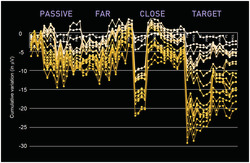- Record: found
- Abstract: found
- Article: found
Scalp‐recorded N40 visual evoked potential: Sensory and attentional properties

Read this article at
Abstract
N40 is a well‐known component of evoked potentials with respect to the auditory and somatosensory modality but not much recognized with regard to the visual modality. To be detected with event‐related potentials (ERPs), it requires an optimal signal‐to‐noise ratio. To investigate the nature of visual N40, we recorded EEG/ERP signals from 20 participants. Each of them was presented with 1800 spatial frequency gratings of 0.75, 1.5, 3 and 6 c/deg. Data were collected from 128 sites while participants were engaged in both passive viewing and attention conditions. N40 (30–55 ms) was modulated by alertness and selective attention; in fact, it was larger to targets than irrelevant and passively viewed spatial frequency gratings. Its strongest intracranial sources were the bilateral thalamic nuclei of pulvinar, according to swLORETA. The active network included precuneus, insula and inferior parietal lobule. An N80 component (60–90 ms) was also identified, which was larger to targets than irrelevant/passive stimuli and more negative to high than low spatial frequencies. In contrast, N40 was not sensitive to spatial frequency per se, nor did it show a polarity inversion as a function of spatial frequency. Attention, alertness and spatial frequency effects were also found for the later components P1, N2 and P300. The attentional effects increased in magnitude over time. The data showed that ERPs can pick up the earliest synchronized activity, deriving in part from thalamic nuclei, before the visual information has actually reached the occipital cortex.
Abstract
Recorded for the first time on the human scalp electrical signals deriving from the thalamus 40 ms after the onset of visual stimulation. The EEG data showed that visual evoked potentials (VEPs) can detect signals that originate from subcortical structures before visual information has actually reached the occipital cortex. These findings indicate that the thalamus not only transmits sensory signals but also acts as an attentional filter. This paper describes sensory and attentional properties of newly defined N40 component of VEPs.
Related collections
Most cited references94
- Record: found
- Abstract: found
- Article: not found
Updating P300: an integrative theory of P3a and P3b.
- Record: found
- Abstract: found
- Article: not found
Low resolution electromagnetic tomography: a new method for localizing electrical activity in the brain.
- Record: found
- Abstract: found
- Article: not found
